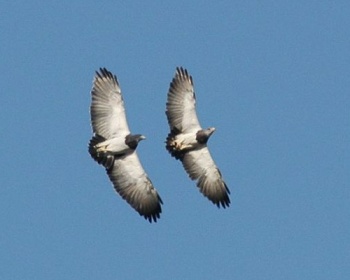(id) |
(Picture of juvenile. References updated) |
||
| Line 14: | Line 14: | ||
[[South America]]: found in [[Venezuela]], [[Colombia]], [[Ecuador]], [[Peru]], [[Bolivia]], [[Chile]], [[Argentina]], [[Paraguay]], [[Uruguay]], and [[Brazil]]. | [[South America]]: found in [[Venezuela]], [[Colombia]], [[Ecuador]], [[Peru]], [[Bolivia]], [[Chile]], [[Argentina]], [[Paraguay]], [[Uruguay]], and [[Brazil]]. | ||
==Taxonomy== | ==Taxonomy== | ||
| − | ====Subspecies<sup>[[#References|[1]]]</sup> | + | ====Subspecies==== |
| − | + | There are 2 subspecies<sup>[[#References|[1]]]</sup>: | |
*''G. m. australis'': smaller, white with fine dark barring below | *''G. m. australis'': smaller, white with fine dark barring below | ||
:*Andes of western [[Venezuela]] to Tierra del Fuego | :*Andes of western [[Venezuela]] to Tierra del Fuego | ||
| Line 23: | Line 23: | ||
A variety of habitats, in open and mountainous areas. | A variety of habitats, in open and mountainous areas. | ||
==Behaviour== | ==Behaviour== | ||
| + | [[Image:Black-chested Buzzard-Eagle immature.jpg|thumb|350px|right|Juvenile<br />Photo by {{user|nkgray|nkgray}}<br />Tiltil district, near Santiago, [[Chile]], August 2012]] | ||
====Diet==== | ====Diet==== | ||
The diet includes mid-sized mammals and birds. | The diet includes mid-sized mammals and birds. | ||
| Line 28: | Line 29: | ||
The large stick nest is constructed in high trees or on rocky cliffs. The clutch of 1-3 eggs is incubated for 28 days. | The large stick nest is constructed in high trees or on rocky cliffs. The clutch of 1-3 eggs is incubated for 28 days. | ||
==References== | ==References== | ||
| − | #{{Ref- | + | #{{Ref-Clements6thOct12}}#Avibase |
#AvianWeb | #AvianWeb | ||
#BF Member observations | #BF Member observations | ||
Revision as of 20:27, 12 May 2013
- Geranoaetus melanoleucus
Identification
62-80cm. Female larger
- White underparts with fine blackish stripes
- Dark grey upperparts with a blackish, brownish or bluish hue
- Dark breast
- Ash-grey and white area on wings
- Very short black tail
Female: rufous tint to both the upper and underwing secondaries
Immature: tail is not nearly as short as in adults; deep brown upperparts, lacks light wing patch; white or light buff underparts, heavy dark streaks on breast, dark bars on belly and thighs. Full adult plumage is acquired at 4-5 years old.
Distribution
South America: found in Venezuela, Colombia, Ecuador, Peru, Bolivia, Chile, Argentina, Paraguay, Uruguay, and Brazil.
Taxonomy
Subspecies
There are 2 subspecies[1]:
- G. m. australis: smaller, white with fine dark barring below
- Andes of western Venezuela to Tierra del Fuego
- G. m. melanoleucus:
Habitat
A variety of habitats, in open and mountainous areas.
Behaviour
Diet
The diet includes mid-sized mammals and birds.
Breeding
The large stick nest is constructed in high trees or on rocky cliffs. The clutch of 1-3 eggs is incubated for 28 days.
References
- Clements, J. F., T. S. Schulenberg, M. J. Iliff, B.L. Sullivan, C. L. Wood, and D. Roberson. 2012. The eBird/Clements Checklist of Birds of the World. 6th ed., with updates to October 2012. Ithaca: Cornell Univ. Press. ISBN 978-0801445019. Spreadsheet available at http://www.birds.cornell.edu/clementschecklist/downloadable-clements-checklist
- Avibase
- AvianWeb
- BF Member observations
Recommended Citation
- BirdForum Opus contributors. (2024) Black-chested Buzzard-Eagle. In: BirdForum, the forum for wild birds and birding. Retrieved 18 June 2024 from https://www.birdforum.net/opus/Black-chested_Buzzard-Eagle






